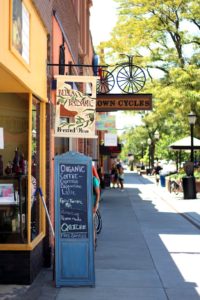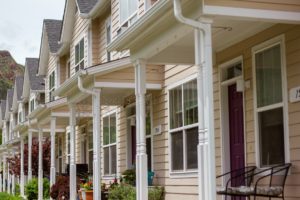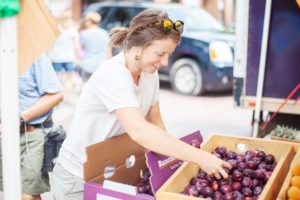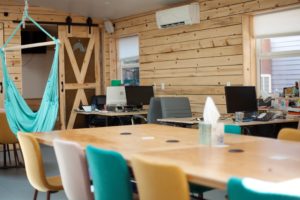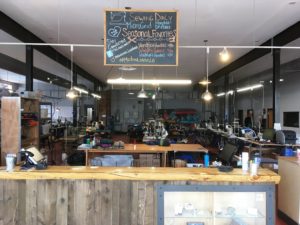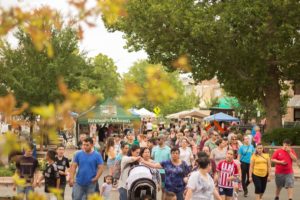This Guest Article for REVITALIZATION is by Bud Tymczyszyn of Community Builders.
As Clark Anderson, the co-founder and Executive Director of Community Builders, pointed out in his May 2019 blog post, Why We Celebrate Small Business Week, small-scale businesses can have an over-sized impact on revitalizing our local economies. They’re responsible for a majority of new job growth (with most of that growth attributed to new small businesses).
And when those small businesses are located in a downtown, they contribute to the vibrancy, authenticity, and economic synergy that make a revitalized downtown an economic powerhouse. Downtowns greatly out-perform their suburban commercial counterparts like malls, strip malls, and big box areas economically. You can read more about that in Community Builders’ About Town report.)
This article will describe some of the things you can do to create a rejuvenating small business environment that helps revitalize your own community.
1) Invest in creating great places
This is an important concept—big enough to warrant writing an entire book about. Fortunately for you, we’ve already written that book. In our Place Value report, Community Builders explored what makes people and businesses drawn to particular communities in the Rocky Mountain West.
After talking to nearly 1,000 employers and community members across Colorado, Idaho, Montana and Wyoming, we found that overall quality of place is the absolute top factor influencing peoples’ decisions to move to, or locate a business in, a particular community.
While that may not sound surprising to you, consider this—employers found quality of place to be a significantly more important factor than zoning, favorable tax structures, and business incentives when deciding where to locate or start their businesses.
So, if your town’s economic development strategy is still largely focused on using incentives to attract outside businesses, that’s fine. But if you’re not focusing on building great, quality places as your number one tactic, you’re missing the strongest and most versatile tool in your revitalization toolbox.
Fortunately, it doesn’t take much to get going on making great places in your community. For starters, check out what these communities are doing this spring to dive into creative placemaking on the cheap.
2) Address affordable housing
Yeah, I know, this one is huge. One of the number one issues we hear from employers and small businesses that are trying to grow in the American West is that they are struggling to find and hire employees because those employees can’t afford to live there.
If you’re seeing more businesses with “Help Wanted” posters than homes and apartments with “For Rent” signs around your town, this is a red flag that a lack of affordable housing is crippling your workforce and holding back your economy.
Yes, addressing affordable housing is hard. Yes, it is doable. And yes, there’s help available. For instance, Community Builders will be rolling out our Affordable Housing Guidebook and a suite of affordable housing webinars, blogs, tools, and resources in late 2019, so be sure to keep your eyes peeled for that.
3) Encourage incrementalism
Businesses have to start somewhere, and more often than not, they start somewhere small. If you’re trying to foster a strong small-business environment in your town, it may be best for you to consider starting small, too.
Source: Mike Thompson, thompsonplacemaking.com
Starting a brick and mortar business is hard, and for many entrepreneurs, prohibitively expensive. So instead of diving straight into a downtown retail space, many small businesses today are getting their start in pop-up tents, food-trucks, or micro-retail spaces and setting their sights on growing. This lowers the barriers to entry, and allows entrepreneurs to test out and adjust their business models as necessary, and with less risk.
Unfortunately, many towns make it unnecessarily hard for small businesses to start small. Local brick and mortar businesses often advocate against small startups like food trucks and micro-retail, not realizing that these smaller pop-ups can often create an economic synergy that revitalizes an entire business district. (For some interesting reads on this, look here and here.)
Local development codes can also include some unnecessary barriers for smaller startups by limiting where mobile vendors can locate, when they can locate, and how many of them can locate in one place. High permit fees and other stringent requirements can also pose a major barrier for micro start-ups.
If you want to create a better environment for micro-scale retail to take off in your town, start by talking with your existing mobile vendors and doing a scrub of your local code to identify some of these barriers and what you can do about them. For some quick tips on this, check out this paper put together by the Libertas Institute of Utah.
(And when you’re ready to take the next step in incremental development, consider attending a workshop with the Incremental Development Alliance.)
4) Know your entrepreneurs
What’s the story of small businesses and start-ups in your town? Who’s doing what? Where are the opportunities, and who needs some support? If these aren’t easy questions for you to answer, it may be time to inventory your entrepreneurs.
When Brian Watson, wizard of co-working spaces and community development at Proximity, helps a community start a co-working space, he begins by creating a giant inventory of all the entrepreneurs and start-ups in the area. This doesn’t just help him understand the market for co-working spaces, it helps the larger community understand what their entrepreneurial synergies are—who’s doing what, and where the opportunities and needs are for supporting more start-ups.
Whether or not you’re interested in starting a co-working space in your community (we’ll talk more about this in just a minute), an inventory of entrepreneurs can be an important tool for any town. To create one, Brian suggests starting with one entrepreneur. Write down their name, what they’re hoping to accomplish, and ask them for the names of other entrepreneurs or start-ups in your town. Then talk to those folks, add more names and details to your list, and repeat.
Once you create a master list of all the entrepreneurs and start-ups in your town, you can start connecting the dots. Are there a lot of small farmers in the community that are looking for more land? Maybe you need a land-linking service like Guidestone Colorado. Are those farmers growing a lot of produce to sell wholesale to out-of-state distributors? Perhaps you can look into Value-Added Cooperatives and some of the resources available for them. (To hear about some of the work Delta County, Colorado is doing on this front, check out Community Builders’ recent webinar.) Do you have multiple web designers, and lots of small businesses with no websites? Try creating a program that links up the two. Great websites are, after all, an essential tool for small businesses.
Also consider making your inventory public, so folks can easily find the small businesses and entrepreneurs that are active in your community.
5) Start a co-working space
Co-working can be a powerful tool for helping small business start, run, or expand.
These spaces provide a space and valuable networking opportunities for entrepreneurs and location-neutral workers, and can have a major impact on kick-starting your local entrepreneurial economy.
A personal anecdote: my wife works out of a local co-working space in Glenwood Springs and has discovered some of her most vital funding resources for her nonprofit startup through the contacts she met there.
If you’re interested in starting a co-working space in your town, I’d suggest watching our above-mentioned webinar, and if you’re in Colorado, check out the state’s Co-Working Initiative.
6) Support your local makers
The maker economy is growing, and doesn’t seem to be slowing down. In short, makers are local small-scale manufacturers that don’t typically need to locate in large industrial facilities to be successful. They’re your local bread baker or coffee roaster. Or, the local brewer or distiller. They can even be the gal or guy down the street who makes hand-crafted knives, bird houses, or hand-tied fly fishing flies in their garage.
The maker movement is gaining a lot of traction in our local communities. When your local coffee roaster or fly-tyer sells their wares online or outside of town, those sales inject outside dollars right back into your community. When these makers want to expand their operations from their garages to a brick and mortar facility, that infusion of outside dollars expands along with them.
There are a handful of things you can do to support your local makers. The first step echoes tip #2 from above—encourage incrementalism. Many small manufacturers get their start by selling their wares in pop-up tents or booths, so if your local policies make it hard for temporary vendors or micro-retail to exist in your town, your local makers will have a hard time selling.
Another way to support makers is to be flexible with your light-manufacturing codes. Oftentimes our zoning codes lump our coffee roasters and beer brewers in with larger industrial uses, pushing them out to the edges of our communities. More often than not, makers and small-scale industry more appropriately fit in (or close to) our downtowns, so be sure your zoning code allows for it.
And if you really want to support makers directly, consider starting or supporting a makerspace. Makerspaces are essentially co-working spaces for these kinds of producers—shared facilities where they can create, network, share tools and resources, and even sell their goods.
There are a ton of these popping up across the country and around the world, and each has its own specialty. Some focus on tech or electronics, while others might be geared more toward food, metal, wood, art, or some blend of all of these. There are a lot of resources out there on this stuff—I suggest starting with this great paper from the National League of Cities.
7) Embrace co-ops
A cooperative business is a private enterprise that is owned and democratically governed by a group of member-owners. There are a lot of different types of co-ops out there, and each has its own unique impacts and benefits to your local economy.
- Consumer co-ops—like most food co-ops—allow the shoppers or consumers to become members and own a single share of the business. This model allows for a business that responds to local needs and puts money and savings back into the hands of the local community. Best of all, consumer co-ops (like food co-ops) tend to be solidly rooted in their communities—unlike private firms that are more footloose and might relocate to the next town that offers juicy enough incentives.
- Worker co-ops are businesses that are owned collectively by its employees. Worker co-ops are great for communities as they create workforces that are better paid and more empowered to be involved in decision making. They also help to redirect the businesses profits back into the pockets of the local workforce, which means more dollars circulating locally in the community. Especially as so many of our historic downtown businesses owners in the West are aging and struggling with succession planning, converting a owner-proprietor business to a worker co-op can be a great way to pass on an existing business and keep ownership local.
- Lending co-ops or investment co-ops are organizations where locals come together to pool money into a fund to invest locally. Since the majority of small business startups rely on personal savings for their startup capital, local, cooperative loans and micro-loans can be a powerful way to kickstart local businesses and entrepreneurs. Neighbors in many communities are figuring out how to pool their money and lend it locally for good. In Minneapolis, neighbors are pooling money to buy vacant buildings and kickstart bakeries and breweries. Neighbors in the tiny town of Sangudo, Alberta used cooperative lending to buy a meatpacking plant that was going out of business, transforming it into a successful worker-owned co-op that is keeping jobs in their town. They then used the revenues from that loan to buy a downtown building and start a coffeeshop. There are a lot of resources out there for cooperative lending—I suggesting starting here, here, or here.
The concept of cooperatives can be hard for folks to wrap their head around, but they are powerful and important tools for local economic development. The best way for you to support co-ops in your community is to patronize them (or become a member-owner!) if you have them, and read up on them and talk about them with your friends and neighbors if you don’t. The more co-ops are understood and talked about by the general public, the more traction they will have in getting started in your community. Co-ops are something we hope to be working on much more at Community Builders, so stay tuned for more resources!
8) Start a small business association
Business associations and chambers of commerce can be a powerful way for businesses to partner, network, share resources, and advocate for one another. If you haven’t seen our recent post on business associations, I highly suggest you check it out!
9) Start a shop local or buy local program
Shop local or buy local programs really can and do work. The more we shop local, the more we keep our dollars circulating within our local economy. There are a lot of resources out there for starting up buy local programs. For starters, we suggest checking out Local Arizona First and some of the videos of founder Kimber Lanning’s talks.
10) Program community events
Community events like farmers markets, first Fridays, third Thursdays, art walks, and pub crawls can be a fantastic way to inject some energy into your local business scene.
Especially in smaller towns where small businesses might close their doors early in the day, coordinated events can be a great way to extend hours and provide business owners with some time-slots when they know that business will be good.
These types of events can take a lot of effort to coordinate, so nesting them under an existing local organization like your chamber, business association, or Downtown Development Authority can be a great way to make sure your event gets the staffing power it needs.
11) Tell their story!
It takes a lot to start a small business. Capital is hard to find, the market is often untested, and even wildly successful small businesses tend to survive on slim margins. This is why it’s important, perhaps now more than ever, to celebrate the small businesses you already have in your town.
What are these small businesses? And how are they impacting your community? If you work for a city or municipality, consider sharing these stories on your website or Facebook (yes, your municipality should have a Facebook account).
If you’re a Downtown Development Authority, Chamber of Commerce, Business Association, or any type of community development organization, consider sharing these stories on your Instagram or Twitter feeds (yes, your organization should be on social media).
And, if you’re an average Jane or Joe or—as am I—someone who really appreciates their local brewery, consider writing a letter to the editor singing their praises and highlighting all that they do for your community. Sharing the story of a small local business you love can give that business the attention it deserves… and might even help to bring in their next customer.
Community Builders (CB) is a non-profit organization based in Glenwood Springs, Colorado. Its staff works to inform, enable and inspire local leaders with the resources and capacity they need to build strong, prosperous and livable communities. CB’s staff brings a unique blend of technical expertise in housing, transportation, land use, and economic development, matched with significant on-the-ground experience in public engagement design and facilitation. CB’s robust approach to engagement seeks to change the way communities dialogue about their futures by creating diverse opportunities for meaningful engagement and developing the leadership and buy-in needed to ensure implementation and create on-the-ground progress.
All photos are courtesy of Community Builders.
About the Author
 Bud Tymczyszyn (tim-chiz-in) is a community planner, designer, and organizer from Glenwood Springs, Colorado. He works as a Project Manager at Community Builders, working every day to help communities across the American West become more vibrant, livable, and equitable places.
Bud Tymczyszyn (tim-chiz-in) is a community planner, designer, and organizer from Glenwood Springs, Colorado. He works as a Project Manager at Community Builders, working every day to help communities across the American West become more vibrant, livable, and equitable places.
He has a Masters in Urban and Regional Planning from Ball State University in Muncie, Indiana- where he also worked for the Delaware-Muncie Metropolitan Plan Commission and Delaware County GIS Department focusing on bicycle/pedestrian planning and advocacy.
Bud’s approach to community planning revolves around a passion for social justice and equity. He is devoted to approaching the public process differently—to putting the community in the driver’s seat and giving local leaders the tools they need to create more equitable and livable places for all.
Prior to his work with Community Builders, Bud was an advocate, outreach worker, and case manager working on housing and homelessness issues in Salt Lake City, UT.


